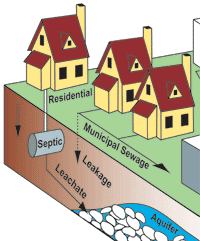
Photo from wikipedia
The presence of pharmaceuticals and personal care products (PPCPs) in the environment is primarily the result of discharge of waste, including from onsite wastewater treatment systems (OWTSs) which are employed… Click to show full abstract
The presence of pharmaceuticals and personal care products (PPCPs) in the environment is primarily the result of discharge of waste, including from onsite wastewater treatment systems (OWTSs) which are employed by 25% of homes in the United States. However, the occurrence and removal of PPCPs in OWTSs is not well understood, particularly given the large diversity in PPCP compounds as well as in OWTS designs. In this study, we monitored 26 different PPCPs in 13 full-scale nitrogen removing biofilters (NRBs), an innovative/alternative type of OWTS that utilizes an overlying sand layer and an underlying woodchip/sand layer to simultaneously remove nitrogen and other wastewater-derived contaminants. The specific objectives of this study were (i) to measure the occurrence of PPCPs in septic tank effluent (STE) that served as an influent to NRBs, (ii) to quantify PPCP removal in three types of NRB configurations (n = 13), and (iii) to evaluate PPCP removal with depth and environmental conditions in NRBs. Aqueous samples were taken during 42 separate sampling events during 2016 - 2019 and analyzed by liquid chromatography tandem mass spectrometry. Analysis of the STE samples yielded detection of 23 of the 26 PPCPs, with caffeine being the most abundant and frequently detected compound at 52,000 ng/L (range: 190 - 181,000 ng/L), followed by acetaminophen and paraxanthine at 47,500 ng/L (190 - 160,000 ng/L), and 34,300 ng/L (430 - 210,000 ng/L), respectively. Cimetidine, fenofibrate, and warfarin were the only compounds not detected. The average removal of PPCPs by NRBs ranged from 58% to >99% for the various compounds. PPCP removal as a function of depth in the systems showed that 50 to >99% of the observed removal was achieved within the top oxic layer (0 - 46 cm) of the NRBs for 19 analytes. Seven of the compounds had >85% removal by the same depth. These results indicate that NRBs are effective at removing PPCPs and that a large portion of the removal is achieved within the oxic nitrifying layer of the NRBs. Overall, the removal of PPCPs in NRBs was comparable (n = 8) or better (n = 15) than that observed for conventional wastewater treatment plants.
Journal Title: Water research
Year Published: 2021
Link to full text (if available)
Share on Social Media: Sign Up to like & get
recommendations!